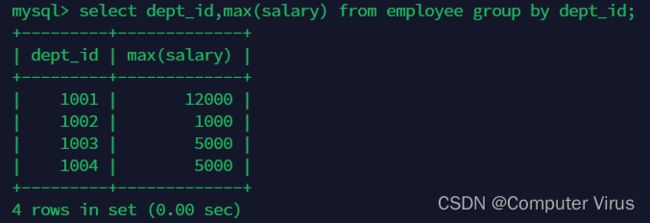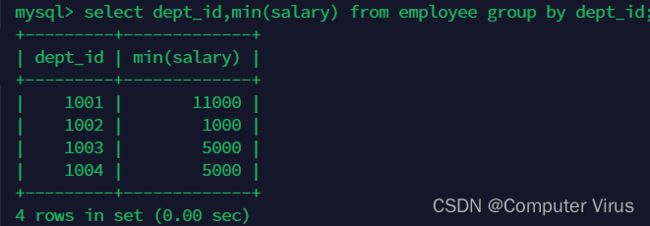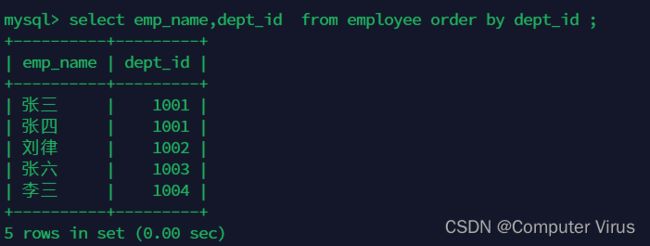mysql之DML的select分组排序
目录
一、创建表employee和department表
1.创建department表
2.创建employee表
3.给employee表格和department表格建立外键
4.给department插入数据
5.给employee表插入数据
6.删除名字为那个的数据
二、分组查询和排序查询,以及对数据的处理(avg,sum,count,max,min)
1.根据dept_id进行分组并查询他们的平均工资
2.根据dept_id分组查询他们年薪平均值
3.根据dept_id分组查询他们薪资的最高值
4.根据dept_id分组查询他们薪资的最低值
5.根据dept_id分组查询他们薪资的总和
6.根据dept_id分组查询人数的总和
7.根据dept_id分组查询人数的总和
8.按照dept_id降序的方式查询emp_name和dept_id
9.按照dept_id和emp_job分组查询薪资总和
10.在dept_id组中限制只查询工资总和大于10000的薪资,并展现出来工作和薪资
四、select查询之limit限制
1.查询前三行数据
2.查询第三条到第七条数据
一、创建表employee和department表
1.创建department表
create table department(
-> depart_id int primary key auto_increment comment '部门编号',
-> depart_name varchar(50) not null comment '部门名称'
-> ) auto_increment=1001;
2.创建employee表
create table employee( n for the right syntax to use near 'redsodsnvjnv' at line 1
-> emp_num int primary key auto_increment comment '员工编号',
-> emp_name varchar(30) not null comment '员工姓名',
-> emp_job varchar(30) not null comment '员工岗位',
-> hire_data datetime not null comment '入职时间',
-> salary int not null comment '薪资',
-> bonus int not null comment '奖金',
-> dept_id int comment '部门编号'
-> );
3.给employee表格和department表格建立外键
alter table employee add constraint emp_dept_fk foreign key(dept_id) references department(depart_id);
4.给department插入数据
insert into department values(null,'科技部门'),(null,'法律部门'),(null,'后勤部门'),(null,'财务部门');
5.给employee表插入数据
insert into employee values((null,'张三','工程师','2023.9.1',12000,1000,1001),(null,'张四','工程师','2023.9.1',11000,1010,1001),(null,'李三','会计','2023.9.1',5000,300,1004),(null,'张六','保安','2023.9.1',5000,500,1003),(null,'刘律','律师','2023.9.1',1000,1,1002);
6.删除名字为那个的数据
delete from employee where emp_name='那个';
二、分组查询和排序查询,以及对数据的处理(avg,sum,count,max,min)
1.根据dept_id进行分组并查询他们的平均工资
select dept_id,avg(salary) from employee group by dept_id;
2.根据dept_id分组查询他们年薪平均值
select dept_id, avg((salary+bonus)*12) from employee group by dept_id;
3.根据dept_id分组查询他们薪资的最高值
select dept_id,max(salary) from employee group by dept_id;
4.根据dept_id分组查询他们薪资的最低值
select dept_id,min(salary) from employee group by dept_id;
5.根据dept_id分组查询他们薪资的总和
select dept_id,sum(salary) from employee group by dept_id;
6.根据dept_id分组查询人数的总和
select dept_id,count(*) from employee group by dept_id;
7.根据dept_id分组查询人数的总和
select dept_ip,count(emp_name) from employee group by dept_id;
8.按照dept_id降序的方式查询emp_name和dept_id
select emp_name,dept_id from employee order by dept_id;
9.按照dept_id和emp_job分组查询薪资总和
select dept_id,emp_job,sum(salary) from employee group by dept_id, emp_job;
10.在dept_id组中限制只查询工资总和大于10000的薪资,并展现出来工作和薪资
select dept_id,emp_job,sum(salary) from employee group by dept_id,emp_job having sum(salary>1000);
四、select查询之limit限制
1.查询前三行数据
select * from employee limit 0,3;
2.查询第三条到第七条数据
select * from employee limit 2,7;
















